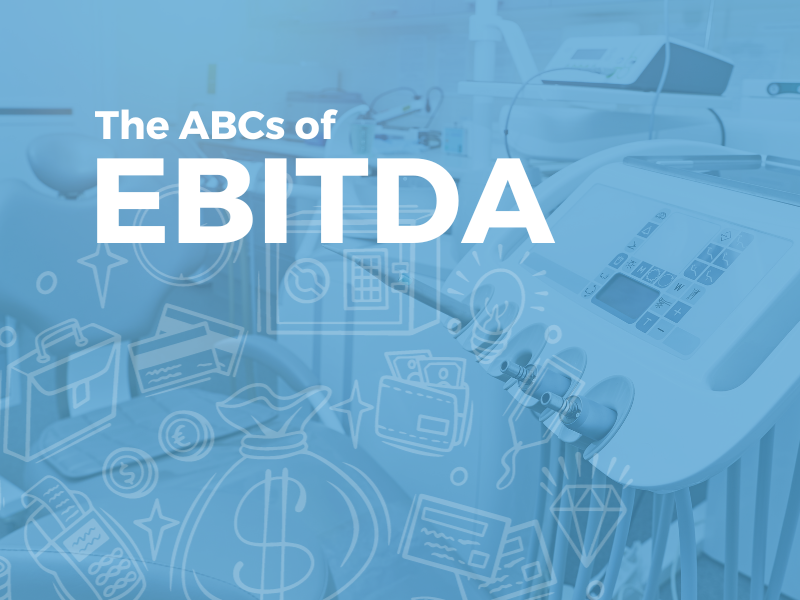In financial analytics, EBITDA, or Earnings Before Interest, Taxes, Depreciation, and Amortization, is a unique term within this specialized field. It is a tool that helps us understand how well a dental practice is doing in its core activities. It sets aside factors like debt, taxes, and accounting methods to focus on the practice’s actual day-to-day operations.
For dental practices, understanding EBITDA is crucial for assessing the health and profitability of the business. It provides a snapshot of how well the practice generates revenue from its core operations, separate from any financial obligations, taxes, or accounting adjustments. This makes it a valuable tool for both current owners and potential investors.

What are EBITDA or Earnings Before Interest, Taxes, Depreciation, and Amortization?
Financial indicators such as EBITDA measure a dental practice’s profitability before interest, taxes, depreciation, and amortization. This is calculated by subtracting a practice’s revenue from its operating expenses, excluding interest, taxes, depreciation, and amortization.
Earnings
In essence, this amounts to the practice’s net income, determined by taking the total revenue and subtracting the expenses for creating products, managing the business, and other day-to-day costs.
Interest
This refers to the cost of borrowing money, including interest on loans, lines of credit, and other financial obligations.
Taxes
This includes all taxes levied on the business, such as income tax, property tax, and other forms of taxation.
Depreciation
This is the reduction in value of physical assets like machinery, equipment, and property over time.
Amortization
As with depreciation, this is the process of reducing a company’s intangible assets over time, such as trademarks, patents, and goodwill.
How EBITDA is Calculated
The formula to calculate EBITDA is:
EBITDA=Revenue-Operating Expenses+Depreciation+Amortization
Alternatively, it can also be calculated starting with net income:
EBITDA=Net Income+Interest+Taxes+Depreciation+Amortization
What Does EBITDA Actually Tell You?
EBITDA serves as a multifaceted lens through which you can view your practice’s financial health. It can reveal key performance indicators such as operational efficiency, liquidity, and overall profitability. It’s akin to a financial MRI, offering multiple slices of insight into the health of your practice. For example, a rising EBITDA could indicate increasing operational efficiency, while a declining EBITDA might signal the need for immediate intervention.
How It Differs from Net Income
Net income and EBITDA are measures of a business’s profitability but serve different functions—net income accounts for all a business’s revenues and expenses, including taxes and interest payments. EBITDA, on the other hand, focuses solely on operational profitability by stripping away interest, taxes, depreciation, and amortization. This allows you to zero in on the core financial performance of your practice, excluding external factors like loan interest and taxes.
The Courses of Action Influenced by EBITDA Assessment
EBITDA can influence various decisions, from day-to-day operational choices to long-term strategic planning. EBITDA can offer invaluable insights whether you’re considering expanding your practice, investing in new equipment, or even contemplating a merger or acquisition. It can serve as a critical metric for potential investors or partners who are evaluating the financial health of your practice.
Is EBITDA the Same as Gross Profit?
Gross profit is ascertained by deducting the Cost of Goods Sold (COGS) from the aggregate revenue generated. In the context of a dental practice, this would encompass the revenue generated from various patient services, such as cleanings, fillings, and other treatments, minus the direct costs associated with providing those services. These direct costs could include dental supplies like gloves, masks, and dental instruments and labor costs for dental assistants and hygienists.
Key Differences Between EBITDA and Gross Profit
EBITDA and Gross Profit are both profitability metrics, but they serve different purposes and offer different perspectives on a dental practice’s financial health.
- Scope of Costs: Gross Profit only considers the direct costs related to the services provided. It doesn’t consider other operational costs like administrative salaries, utilities, or rent. EBITDA, however, includes these operational costs, offering a more comprehensive view of profitability.
- Level of Detail: Gross Profit provides a more granular view of the profitability of individual services or treatments. EBITDA, in contrast, gives a broader picture, encompassing the entire operational aspect of the practice.
- Financial Complexity: EBITDA is often considered a more complex metric as it involves more variables, including interest, taxes, depreciation, and amortization, which are excluded to focus on operational earnings.
Scenarios Where One Might Be More Useful Than the Other
The utility of Gross Profit and EBITDA can vary depending on the specific financial questions you’re looking to answer.
- Service-Level Decisions: If you’re evaluating the profitability of specific dental services or contemplating whether to discontinue a particular treatment, Gross Profit is the go-to metric. It allows you to assess the direct profitability of each service, helping you make targeted decisions.
- Strategic Planning: For broader strategic initiatives like practice expansion, acquisition, or even a potential sale, EBITDA serves as a more appropriate metric. It offers a holistic view of the practice’s financial health, which is crucial for long-term planning and decision-making.
Can EBITDA Be Misleading?
EBITDA is a valuable tool for assessing operational profitability but is not an all-encompassing measure of financial viability. One of its primary limitations is that it doesn’t account for capital expenditures, such as the costs associated with acquiring new dental equipment or renovating your practice. Furthermore, EBITDA overlooks variations in operational funds and debt settlement plans, which can considerably sway the cash reserves and comprehensive financial well-being of a dental operation.
EBITDA can sometimes offer a misleadingly optimistic view of a practice’s financial health. For example, a dental practice might show a high EBITDA margin but also have substantial debt levels due to loans taken out for new equipment or expansion. In such cases, the high EBITDA could give the illusion of robust financial health, while the practice might actually be struggling with debt repayments. Similarly, if a practice has recently made significant capital expenditures, the EBITDA won’t reflect these costs, potentially masking financial strain.
How to Use EBITDA in Conjunction with Other Financial Metrics
To obtain a well-rounded view of your dental practice’s financial health, EBITDA and other key financial metrics should be considered.
- Net Income: This provides a more comprehensive picture of profitability, including all expenses and income streams.
- Cash Flow: Cash flow statements can offer insights into the liquidity of your practice, helping you understand how well you can meet short-term financial obligations.
- Debt Ratios: Metrics like the debt-to-equity ratio can give you a better understanding of your practice’s financial leverage and risk.
What is a Good/Healthy EBITDA Margin for a Dental Practice?
A healthy EBITDA margin for dental practices generally hovers between 15-25%. This range serves as an industry standard and offers a reliable baseline for gauging the financial health of your practice. However, it’s essential to note that these are general figures and can vary significantly based on many factors. For instance, a newly established practice may initially have a lower EBITDA margin, which could gradually improve as the practice grows and becomes more efficient.
Factors That Can Influence EBITDA Margins in Dental Practices
Several variables can impact the EBITDA margins of a dental practice, and understanding these can help in more accurate financial planning.
Location
A practice in a high-cost urban area may incur higher operational expenses, from rent to utilities, negatively affecting the EBITDA margin. Conversely, a practice in a less expensive area may benefit from lower operating costs, boosting its EBITDA margin.
Patient Volume
The number of patients a practice serves directly correlates with its revenue. A higher patient volume often leads to an improved EBITDA margin, provided the operational costs are managed efficiently.
Operational Efficiency
Streamlined operations can significantly enhance EBITDA margins. This includes efficient staff management, optimized appointment scheduling, and effective inventory control.
How to Improve Your Dental Practice’s EBITDA Margin
Improving the EBITDA margin of a dental practice is a multifaceted endeavor that involves both boosting revenue and curtailing costs. Here are some strategies:
Optimizing Appointment Scheduling
An optimized schedule can lead to more appointments and, consequently, higher revenue. Utilizing scheduling software can help minimize gaps and ensure that the practice operates at full capacity.
Investing in Efficient Equipment
While this requires an upfront investment, efficient, modern equipment can improve operational speed and quality of service, leading to higher patient satisfaction and, ultimately, increased revenue.
Renegotiating Supplier Contracts
Periodically reviewing and renegotiating contracts with dental materials and equipment suppliers can result in cost savings, thereby improving the EBITDA margin.
Case Study: EBITDA in Action
Let’s consider “SmileBright,” a dental practice that has been operational for five years but is facing some financial challenges. SmileBright struggled with outdated equipment and a high turnover rate among dental assistants, leading to operational inefficiencies and decreased profitability.
SmileBright’s management used EBITDA to identify areas for cost-cutting and investment. They decided to invest in new equipment and staff training to improve operational efficiency. After implementing the changes, SmileBright saw a 20% increase in EBITDA, confirming the metric’s value in guiding effective decision-making. However, they also learned the importance of using EBITDA and other financial metrics to better understand their practice’s health.
Conclusion
EBITDA is an indispensable metric for assessing the operational profitability of a dental practice. It provides a focused snapshot of your core financial performance, filtering out external variables like interest, taxes, and depreciation. This makes it an excellent starting point for any economic analysis.
However, it’s essential to understand that EBITDA is not a standalone metric. While it offers valuable insights into operational earnings, it doesn’t account for other crucial financial aspects like capital expenditures, debt repayment, or changes in working capital. Therefore, relying solely on EBITDA could lead to an incomplete or misleading picture of your dental practice’s financial health. It’s advisable to use EBITDA with other financial indicators to avoid such pitfalls—metrics like net income, cash flow, and debt ratios.
By embracing a poly-metric methodology in your financial analysis, you can cultivate a more intricate and comprehensive grasp of your dental practice’s fiscal position. Such a holistic perspective is indispensable for formulating judicious choices that enhance operational efficacy and attenuate hazards. This multi faceted approach paves the way for sustainable growth and enduring financial prosperity, a philosophy you can further explore through resources available at SPP Dental Partners.
